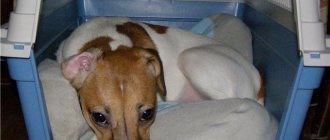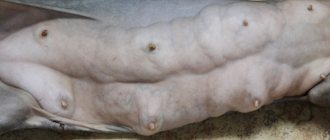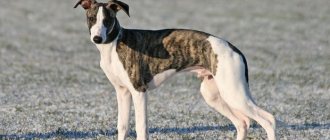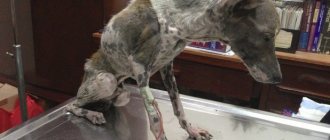Owners of modern German Shepherds are united in the largest cynological organization of one breed (WUSV), which is part of the Fédération Cynologique Internationale (FCI).
“The German Shepherd is, first and foremost, a working dog!” — considered the creator of the breed, von Stefanitz. This motto is still relevant today. The modern German Shepherd is a strong and resilient animal due to the harmonious combination of height, weight and shape. She is the personification of nobility, devotion, and good management. And these are mandatory properties for a working and protective dog.
Appearance of a modern German Shepherd
The parameters (height, weight, character) of the breed standard remain unchanged, but every 10-15 years new requirements appear for color, topline shape, shin length and articulation angles. The constitution is approaching strong dry due to problems with hip dysplasia.
The modern German Shepherd should
- be balanced from a biomechanical point of view: have good leverage, correct joint angles, be compact, medium-sized, big-headed, with strong ligaments. Balance ensures endurance;
- have good pigmentation, black and red (black and white) color is preferred;
- be mobile, strong, impulsive.
The biomechanical characteristics of the German Shepherd have been brought to such a level that in terms of running speed it is not inferior to the Doberman. Dogs that are certified in SV and conformation tests are used for breeding. But, despite the rigidity in selection, brightly colored black-backed Germans lose their service qualities after several generations.
The German Shepherd standard assumes three types of color: black, saddle-back, zone-gray.
Black-backed Germans lose in work championships to dogs with a zone-gray color. Professional trainers prefer to work with “zonars”. The zone-gray differs from the saddle-gray in that the color of the saddle-gray wool is purely black, while in the zone-gray each saddle-gray hair is divided into zones: black, gray, yellow, black and light at the base. Zoned gray puppies are born red and differ from their black littermates in better health, strong character and leadership qualities.
Genetics explains this by the fact that gray color is dominant in relation to other colors of the German Shepherd. In order not to lose the working qualities of the breed in pursuit of the exterior, breeders use zone-gray sires in breeding.
German Shepherd Working Lines
Home → Articles → Keeping and breeding dogs → Working lines of the German Shepherd
Within the category of European working lines there are several subtypes:
- western work lines;
- Czech work lines;
- East German Work Lines (East German Work Lines);
- Dutch lines;
- Belgian lines.
Each line has differences in appearance and character.
Dutch and Belgian dogs (although they can be classified as West German working lines in terms of pedigrees) tend to be more strongly driven and less sensitive than other types due to the preferences of breeders in these countries.
Developing in communist Eastern Europe, very different preferences, goals and culture of the time led to the Czech and DDR dog lines, they tend to be more suspicious of strangers, more aggressive and slower to mature.
But they all belong to the term "Working Lines" for two reasons.
Firstly, they all have much more similarities with each other than with the German show lines in appearance and character.
And secondly, they all pursue one common breeding goal: the priority of working qualities.
German Shepherd Working Lines
Working line dogs are bred for their working abilities. These dogs are also assessed for breed suitability, and breeding partners are selected based on their ability to not only work well, but also produce strong, balanced working dogs.
Instead of prioritizing angular design or movement or color, working line breeders focus on traits such as instinct, toughness, courage, intelligence, desire to work, nervous system strength and character.
The goal is to obtain a dog that is not only good enough to pass "SchH 3" or perform service, but which will surpass other working dogs in its characteristics.
Health is a huge priority for working line breeders. Since this is the main necessity for their purposes. No matter how excellent a dog is in character, if it is sick, it is of no use as a service dog.
Similarly with the exterior (addition). Many working line breeders occasionally show their dogs in conformation shows, but most do not. In any case, the main judge of a dog's conformation is its ability to do the job, regardless of whether the dog has a conformation score or not.
These dogs must be fast and agile, strong and powerful, show great endurance, and be able to withstand a lot of physical stress day in and day out.
Working line breeders breed dogs with practical, utilitarian builds that allow them to get the job done. Without the modern quirks seen in the conformation rings. The structure of working line dogs has changed little over time, and in appearance the modern working dog is much more reminiscent of the original German Shepherds that were at the origins of the breed than any dog from modern show lines.
Since working dogs are not bred to conform to a specific show-approved conformation pattern, they can come in a variety of sizes, colors, and builds (as allowed in the breed, of course).
Some are shorter in body and stockier. Some are taller and thinner. Most have a standard dense coat, but "plush" and long coats are found. These dogs can be any of the standard German Shepherd colors, with the zoned gray color being the most common (simply because it is genetically the most dominant). Black-backed dogs are also common, as are pure black or black and tan dogs.
In terms of character, working-bred dogs have stronger drives, higher energy, and are more steadfast in training and handling than other types of dogs. Many of these Shepherds have a huge work temperament and desire to work, many can be quite demanding in their need for exercise, exercise and mental stimulation.
To bring closer the differences between the two types of German Shepherd within the SV Union, the World German Shepherd Union WUSV began holding a Universal Breed Championship in 2011, where the dog must participate in both training competitions and in the exhibition to receive a total rating for conformation and working qualities .
Characteristics of a good working dog.
Instincts are an innate form of behavior. They are triggered by external stimuli and serve to survive in the wild. For example, the prey instinct arises from the natural hunting behavior of wolves: stalking, chasing, capturing, shaking (ritual bashing) and killing.
Instinctive responses are automatic, strong and if the instinct is evoked, it can be very insatiable.
Human selection through breeding and selection has modified and shaped these instincts over time. We have endowed certain breeds with certain instincts because they are necessary to serve the purpose for which the dog breed was bred. But even within the same breed, individual dogs have different strengths of instincts and different thresholds of instincts.
There are many instincts: hunting, prey, social, protective, etc. Many of them in one form or another are necessary for working dogs, but the prey instinct is the most necessary.
A service dog must have a strong prey drive, as this drive is one of the primary tools used in all aspects of training, from tracking to protection, obedience, substance detection, etc.
Instincts give the dog a reason to work and a love for work, thus providing the trainer with an easy, innate system in which to motivate, reward and correct the dog. Many other instincts, such as feeding, hunting and packing, are also important for working dogs. Although ideally, these specific instincts should be present and strongly expressed.
Temperament is a rather subjective term that describes a dog's overall behavior and personality. There are as many different ways to judge character as there are people and dogs. However, service dogs must have a certain character and possess certain specific traits. They are energetic and get great joy from working with their owners. They must be calm and gentle with children, but have courage and confidence when they or their family are threatened. And they must have the intelligence to read the situation and respond accordingly. They should be curious, not shy when placed in a new environment. They must show loyalty and a desire to work and please their handlers.
The dog's nervous system is closely related to its character. The dog's reaction when it finds itself in a tense, or possibly potentially threatening, situation depends on the nervous system.
A dog with a firm, strong nervous system will not back down from a problem. In protection work, when the helper behaves harshly, the dog also becomes harsher. She shows confidence and courage in every situation when faced with a threat, and will confront the threat rather than try to avoid it. Dogs with a strong nervous system are not easily frightened.
On the other hand, a dog with a weak nervous system may become easily startled and may become agitated and fearful when encountering strange people, environments, sounds, objects and territory. She will feel threatened even if the threat does not actually exist, and will react to the threat by trying to avoid it or run away. If she cannot escape, she will either withdraw, cowering and showing submission, or lash out in an attempt to make the threat disappear. She will not face the threat with confidence. A dog with a weak nervous system chosen for personal protection or as a patrol dog is a life-threatening responsibility.
But having a strong character is not enough, it must also be what we call “environmentally resistant”. A dog with a strong nervous system will not be bothered by loud and busy environments, crowds of people, traffic, loud noises, noise, slippery surfaces under paws, confined spaces, darkness, wobbly support underneath, or heights. Tolerance to the environment is the second aspect of the nervous system that is essential to a good working dog.
Of course, it is important that a working dog has the appropriate psychological characteristics, but all of them are nothing if the dog is physically incapable of doing the work. Physical strength should be the goal of every breeding program. For working dogs, this means that the dog has the strength, speed, agility and coordination to get the job done.
In addition to proper size and good athleticism, it is very important that the working dog is in excellent health and free from joint dysplasia and other diseases. This should be the result of good breeding and good health care on the part of the owner.
All articles
Using German Shepherds to Ensure the Safety of People and Facilities
This is a versatile service dog. It is used as:
- wanted;
- protective guard;
- patrol station;
- guard room
It is used to find explosives, as well as leaks in gas and oil pipelines. It is able to work in any conditions: indoors, outdoors, in crowded places, in vehicles and in any weather. It can easily be transported in combat vehicles and aircraft and is used to protect the state border. The German Shepherd is an excellent bodyguard.
Methods for special types of training differ from tests in the SV system. Individuals who own a German Shepherd should know that it has such a breed quality as toughness and in extraordinary situations it can be defeated. Therefore, the owners of this breed are obliged to begin raising and training their pet from an early age.
Maintenance and care
These dogs are very active, they need exercise not only for the body, but also for the mind. Remember to combine daily walks with exercise - be it obedience exercises or simply playing with a ball.
“Germans” are independent, sometimes requiring harsh education and treatment, but they achieve high results in complex training courses, including special ones.
You should immediately realize that not every person can cope with raising and raising a large service dog.
German Shepherd coat care is limited to brushing once a week.
The ideal owner for a German Shepherd is a person who is able to show sufficient persistence and demand respect from the dog, while not forgetting to respect him.











